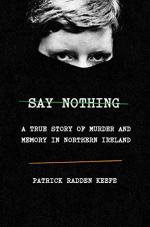|
This section contains 526 words (approx. 2 pages at 400 words per page) |

|
Say Nothing: A True Story of Murder and Memory in Northern Ireland Summary & Study Guide Description
Say Nothing: A True Story of Murder and Memory in Northern Ireland Summary & Study Guide includes comprehensive information and analysis to help you understand the book. This study guide contains the following sections:
This detailed literature summary also contains Topics for Discussion on Say Nothing: A True Story of Murder and Memory in Northern Ireland by Patrick Radden Keefe.
The following version of this book was used to create the guide: Keefe, Patrick Radden. Say Nothing: A True Story of Murder and Memory in Northern Ireland. Doubleday, 2019.
Say Nothing is divided into 30 chapters, with Chapters 1 – 10 forming Book 1, “The Clear, Clean, Sheer Thing”; Chapters 11 – 20 forming Book 2, “Human Sacrifice”; and Chapters 21 – 30 forming Book 3, “A Reckoning.”
The chapters in Book 1 introduce the reader to Northern Ireland in the 1970s, describing the historical and cultural legacy of sectarian strife, the role of the IRA in family and society life, the key figures of the republican movement – Dolours Price, Brendan Hughes, and Gerry Adams – as well as the story of the disappearance of Jean McConville. Keefe thus sets the stage for a repeated return to the McConville issue throughout his book, following its particular and personal development as he traces the broader contours of the republican movement as it became more and more violent in this time period. The phrase “The Clear, Clean, Sheer Thing,” stems from a poem by a republican writer and describes the way that Price, Hughes, and Adams operated in their secret missions for the IRA: they had no limits to what they felt capable of doing in the name of the ‘clear,’ ‘clean,’ ‘sheer’ ideals they held regarding Irish republicanism.
The chapters in Book 2 recount the aftermath of the hey-day of republican activities: with Dolours Price, Brendan Hughes, and Gerry Adams all serving long prison sentences, they were forced to come to terms with their actions and goals for the movement. Whereas Dolours Price experienced a traumatic hunger strike, ultimately earning herself her freedom by bargaining with Prime Minister Thatcher, Brendan Hughes led a similar strike that not only resulted in six republicans dying but also did not earn him his freedom. He was eventually released, only to find that he no longer recognized the movement. Gerry Adams, meanwhile, found that violent tactics were not as effective for the IRA as they once had been. He led the movement into more political territory, becoming the leader of the Sinn Féin party and a Member of Parliament. He steered the movement away from its bloody past, but isolated himself from his former friends along the way.
In Book 3, the McConville children who had lost their mother decades ago are now adults with a rage against the IRA and its disappearing tactics. This book describes the grieving processes and body searches undertaken by all those left behind after the IRA disappearances. Keefe describes the academic project called the Boston Project which led to the recorded interviews of several IRA members including Dolours Price and Brendan Hughes. The interviews served as a cathartic moment for such people who had confessions they had been longing to tell. Yet, the interviews involved the project’s leaders in lawsuits, international political games, and ultimately raised as many questions as they could answer. Book 3 concludes with Keefe’s rumination on the way in which the truth can help reconciliation efforts in war-torn societies. He finds that Gerry Adams’ continued silence on his own role in the IRA contributes little to Northern Ireland’s drawn-out and complex attempt at healing.
Read more from the Study Guide
|
This section contains 526 words (approx. 2 pages at 400 words per page) |

|



